how to draw a tree branch without leaves
The branches of trees are often the hardest parts to draw. Too many branches or branches that are too straight can ruin the appearance of a tree. In this branch drawing tutorial, we guide you through the process of creating a realistic tree branch outline. The skills that you will gain from this tree branch drawing tutorial will help you create more realistic trees in the future.
Table of Contents
- 1 Easy Branches Drawing Tutorial in 16 Steps!
- 1.1 Step 1: Outline the Shape of Your Tree Branch
- 1.2 Step 2: Draw Some Leaves
- 1.3 Step 3: Create a Second Bunch of Leaves
- 1.4 Step 4: Add the Final Leaves to Your Branches Drawing
- 1.5 Step 5: Apply a Base Coat of Color to Your Tree Branch Outline
- 1.6 Step 6: Color the First Bunch of Leaves
- 1.7 Step 7: Continue Coloring the Leaves
- 1.8 Step 8: Finish Coloring the Leaves
- 1.9 Step 9: Add A Second Color to the Branch Drawing
- 1.10 Step 10: Create Shadows on Your Branch Drawing
- 1.11 Step 11: Highlight Your Tree Branch
- 1.12 Step 12: Add Color Detail to the Leaves
- 1.13 Step 13: Shade the Leaves
- 1.14 Step 14: Enhance the Structure Lines
- 1.15 Step 15: Blend the Color on the Leaves
- 1.16 Step 16: Finish Your Tree Branch Drawing
- 2 Frequently Asked Questions
- 2.1 How to Draw Bark on a Tree Branch?
- 2.2 What Colors Do You Need for a Tree Branch Drawing?
Easy Branches Drawing Tutorial in 16 Steps!
Although branch drawing may seem a little tricky, we break it down into 16 very easy-to-follow steps. We begin with some basic construction steps, creating a light outline of our branch drawing. Following this, we begin to define the tree branch drawing with a little more detail using color to create depth and dimension. You can see a brief outline of all of the steps in the image below.
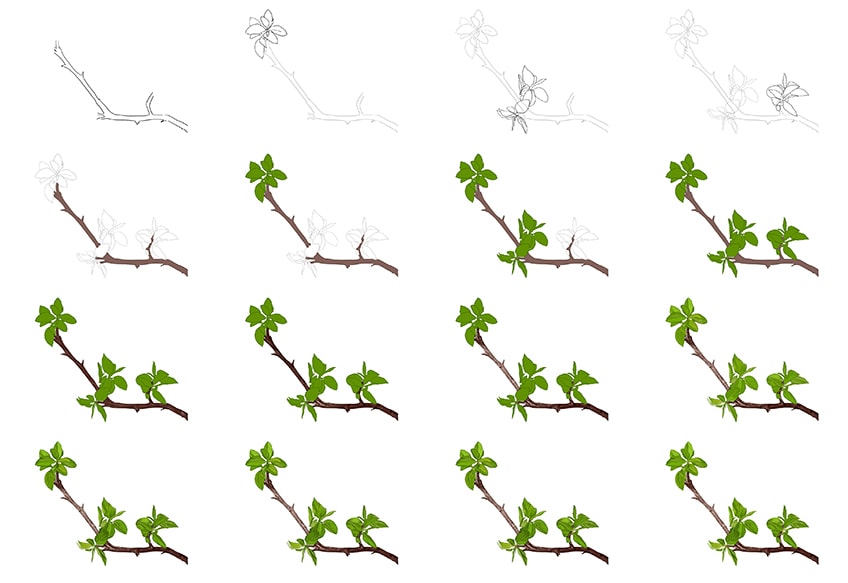
You can see from the outline that coloring steps make up the majority of this tree branch drawing tutorial. We love this tutorial because it is suitable for any medium that you choose to use. Whether you are a physical artist who loves to use paint or pastel, or you prefer to work digitally, you can easily adjust the steps to suit your own unique needs.
With that being said, find somewhere comfortable to sit, gather your supplies and a cup of tea, and let us begin learning how to draw a tree branch!
Step 1: Outline the Shape of Your Tree Branch
We begin this tutorial by creating an elementary tree branch outline. Use a light pencil, or a separate layer on your tablet, to create the outline of your main branch. In our example below, we begin the branch in the lower right corner of the drawing area and extend it up to the upper left side. The branch should become slightly thinner as you reach the end, and you can create several smaller and thinner off-shoots.
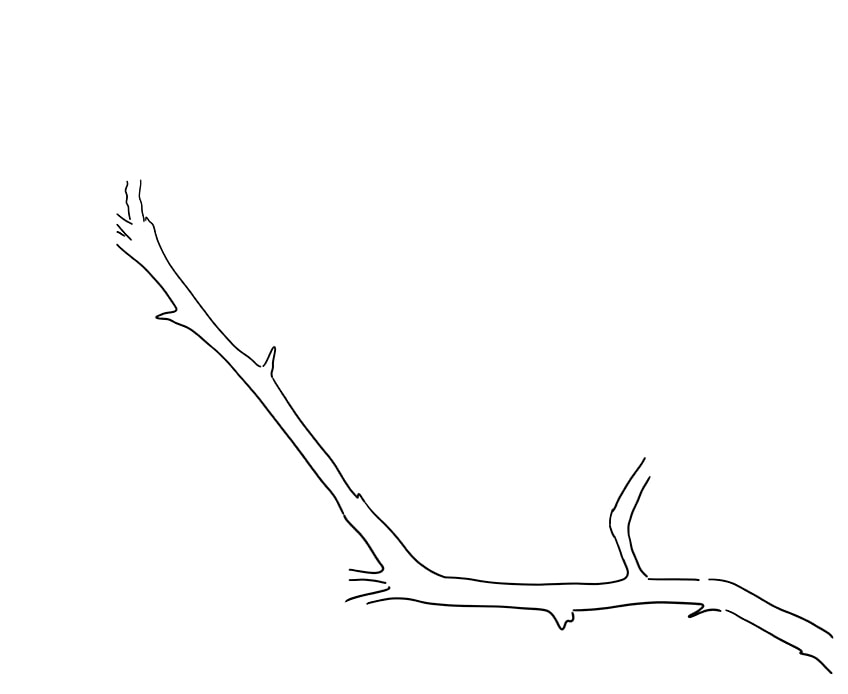
Step 2: Draw Some Leaves
Now that we have the base of our tree branch outline done, we can begin to add some details. At the top left end of your tree branch drawing, begin creating several leaves. These leaves should be stacked above each other in layers. They should also flow outwards on all sides, creating a flower-like bunch.
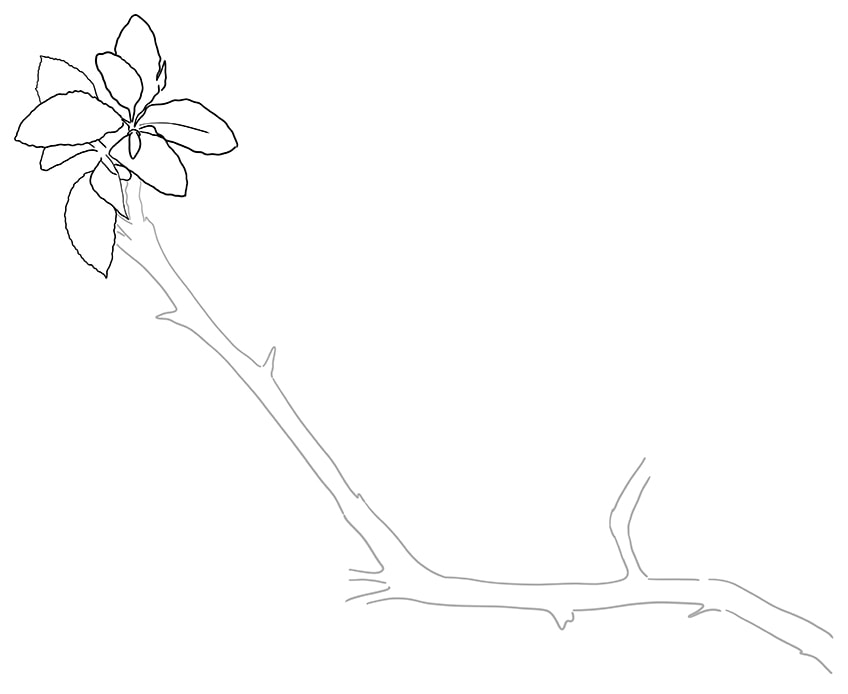
Step 3: Create a Second Bunch of Leaves
We are going to continue drawing leaves on our tree branch outline in this step. At around the halfway point in your branch, draw two more bunches of leaves. These leaves can be at different angles, with some being thinner or fatter than others.
Take your time with this process, as the more purposeful you are, the more realistic your tree branch drawing will look.
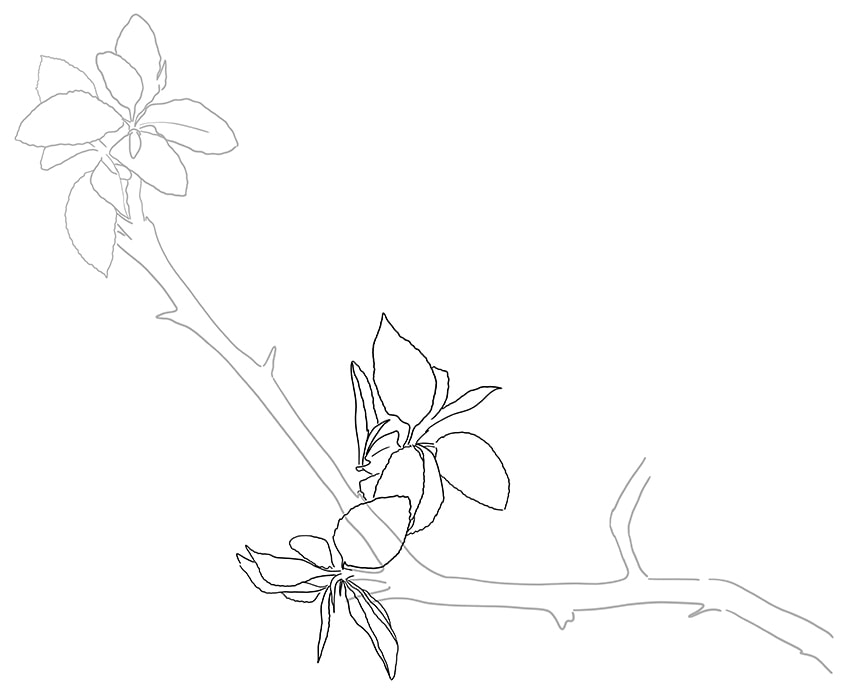
Step 4: Add the Final Leaves to Your Branches Drawing
Before we begin adding color and texture to our branch drawing, we are going to add one final clump of leaves. On the first smaller branch extension on the right of your branch, draw a similar bunch of leaves. As with the previous two steps, these leaves should be flowing outwards in different directions, and they should be varied in curve and position.
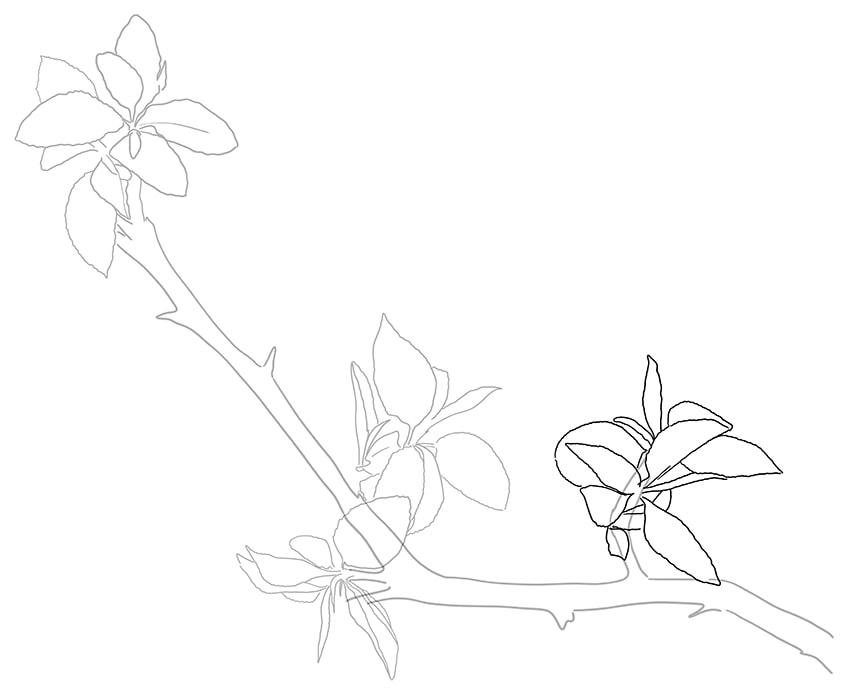
Step 5: Apply a Base Coat of Color to Your Tree Branch Outline
In this step, we are going to begin the coloring process for our tree branch drawing. You will need a regular paintbrush and some brown paint. The exact shade of brown that you choose is up to you, but it should be of a middling tone. We are going to add highlights and contours later in the tutorial, so you need a color that is somewhere in between. Using these tools, create an even coat of color on the entire branch outline.
This includes any visible portions between your leaves.
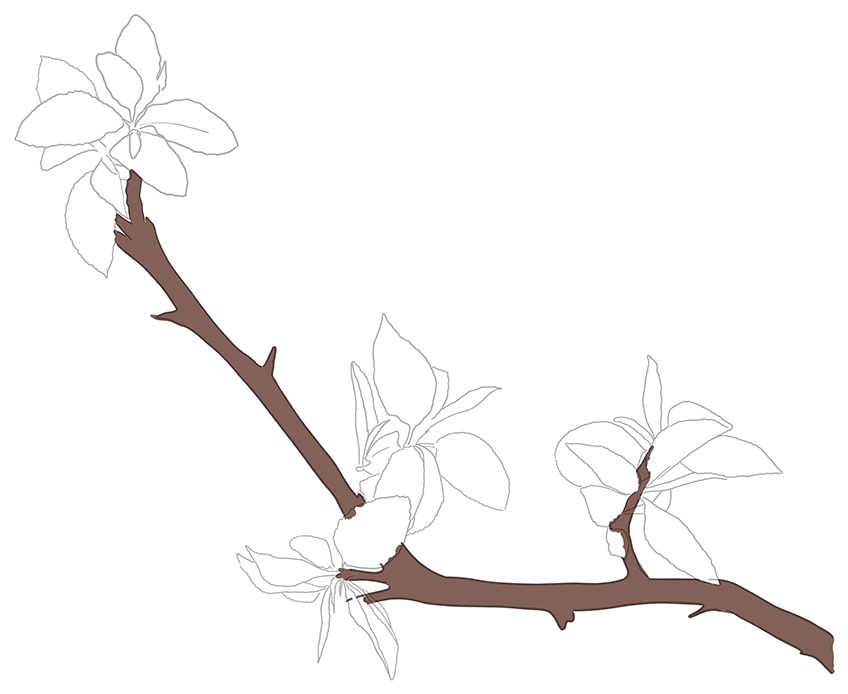
Step 6: Color the First Bunch of Leaves
We are going to break down the leaf coloring into the same steps that we used for drawing them. Beginning with the bunch of leaves on the very end of your tree branch outline, we are going to create a simple base color coat. Use a regular brush and some olive green paint to carefully color each individual leaf evenly.
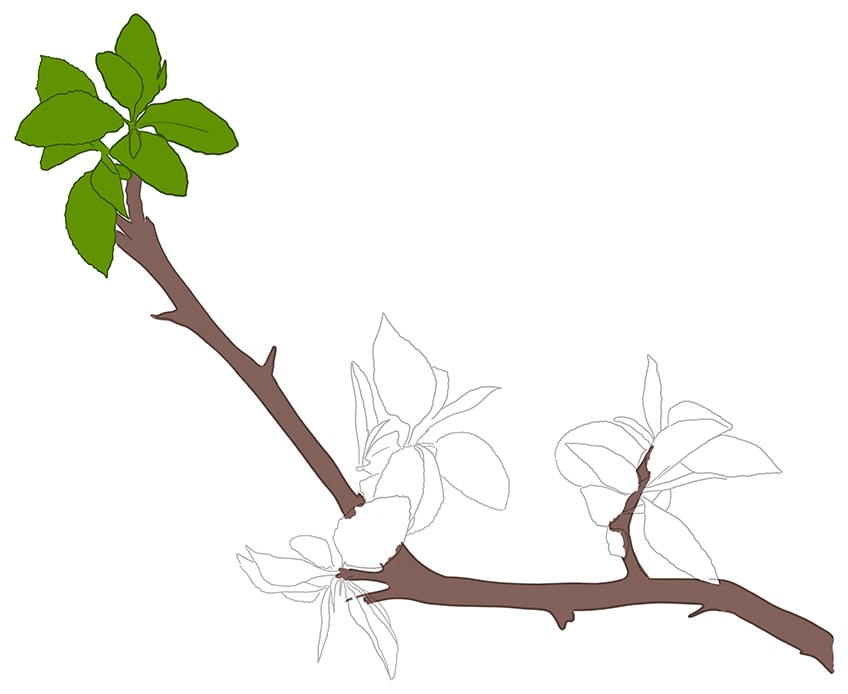
Step 7: Continue Coloring the Leaves
You can now simply repeat the previous step, coloring in the middle bunch of leaves with the same green color. You may need a finer brush for some of the smaller leaves.
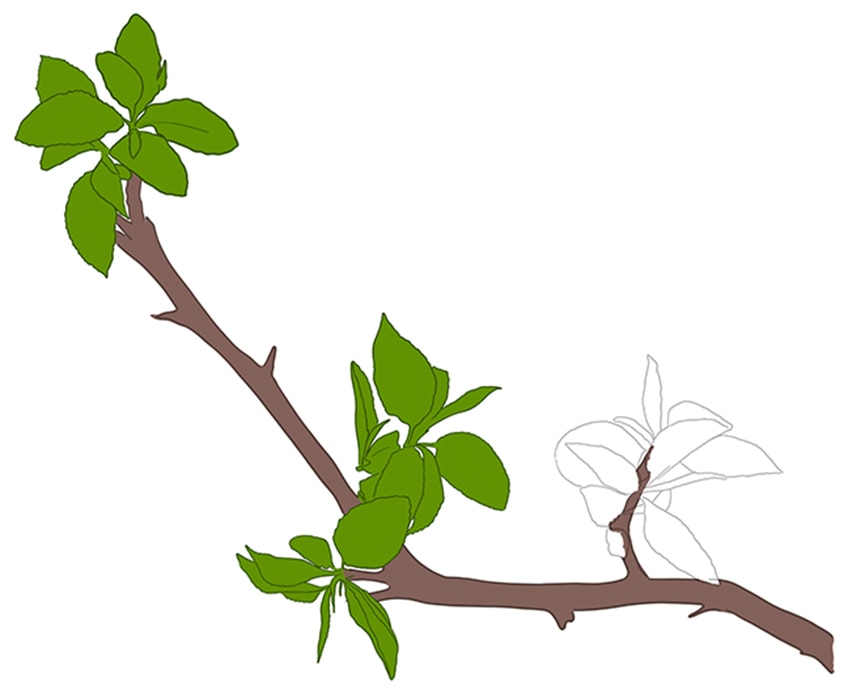
Step 8: Finish Coloring the Leaves
In this step, you can complete the leaf coloring process by filling in the last remaining bunch. For leaves that overlap with each other, take only one pass with the paint. You want each leaf to have a single and even coat of color without any darker patches.
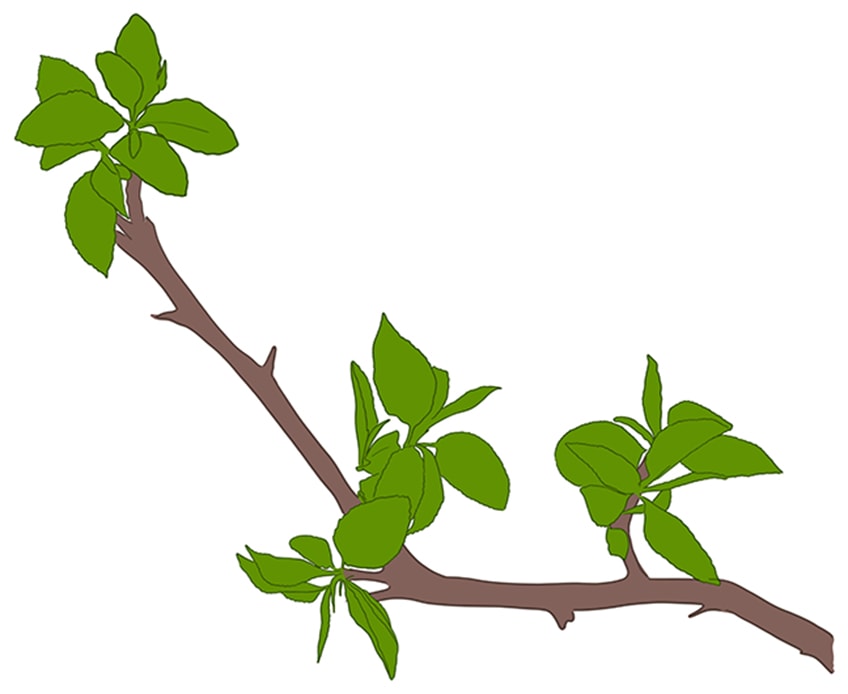
Step 9: Add A Second Color to the Branch Drawing
One of the biggest questions when it comes to painting trees is how to draw bark. In this tutorial, we show you how to draw bark by gradually building up different patterns with several layers of brown shades. We begin this process now, using a small blending brush and a darker brown shade of paint. Use these tools to fill most of the tree branch outline, leaving some subtle but visible patches of the base color peeking through.
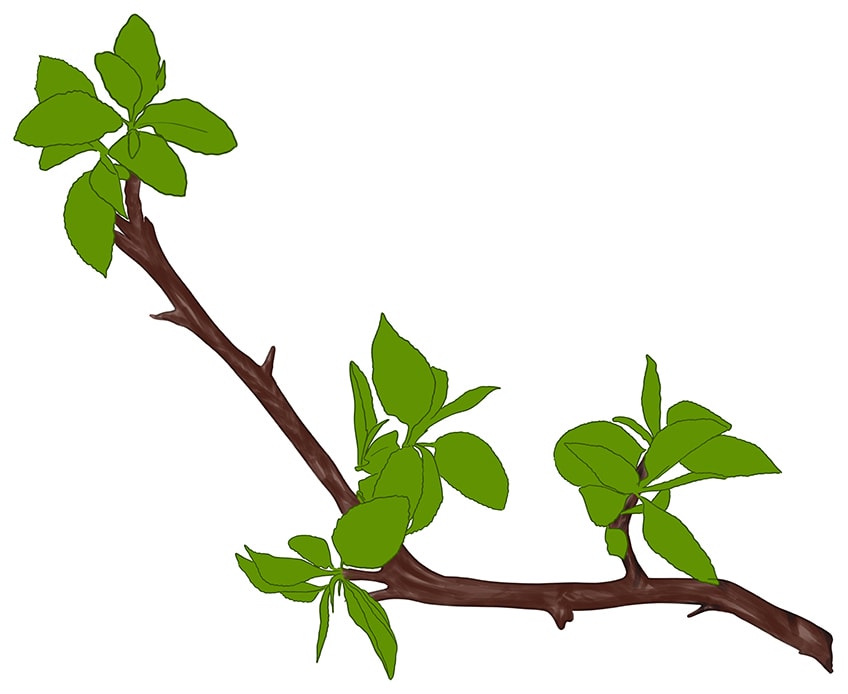
Step 10: Create Shadows on Your Branch Drawing
We are now going to continue to add depth and dimension to our tree branch drawing, using an even darker shade of brown paint. Using a small blending brush, apply a second soft coat of dark brown patches along the edges of the main branch. You can also shade the smaller subsidiary branches, enhancing the structure and creating a more three-dimensional branch.
Finish this step using a small blending brush and some light caramel paint to carefully apply brush strokes onto the bottom branch in the middle.
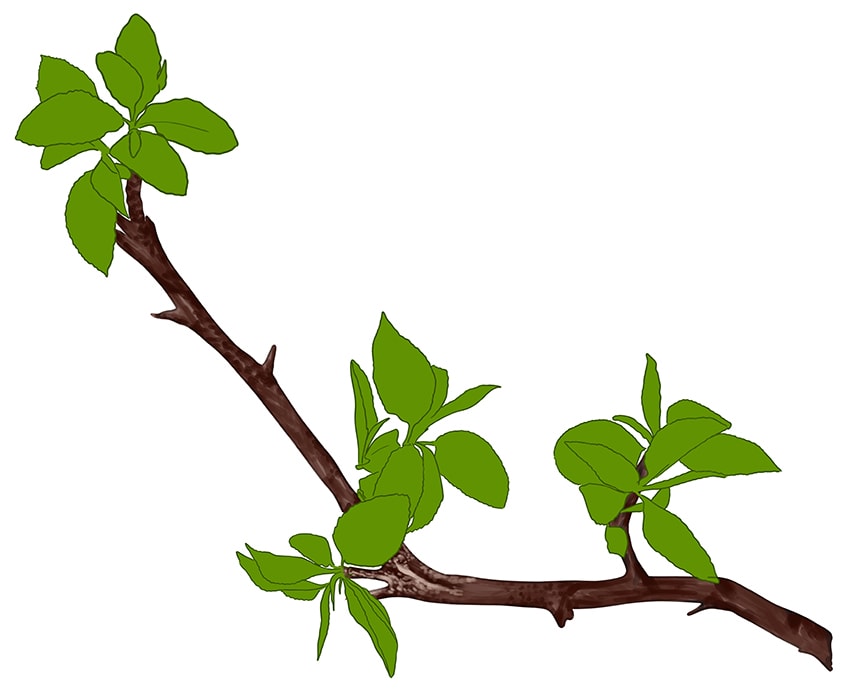
Step 11: Highlight Your Tree Branch
Now that we have created some shaded dimension in our tree branches drawing, we can begin to compliment it with some highlights. The highlights will help us create a realistic bark texture. Begin with a small blending brush and your caramel paint. Apply a light, dappled coat of color along the top half of the branch. You can then repeat this process with a light brown color, adding short brush strokes and dots on the lightened area.
Tip: use a small blending brush to dab along the branch creating uneven patches of color. Complete the step by using a clean blending brush to soften the color coats.
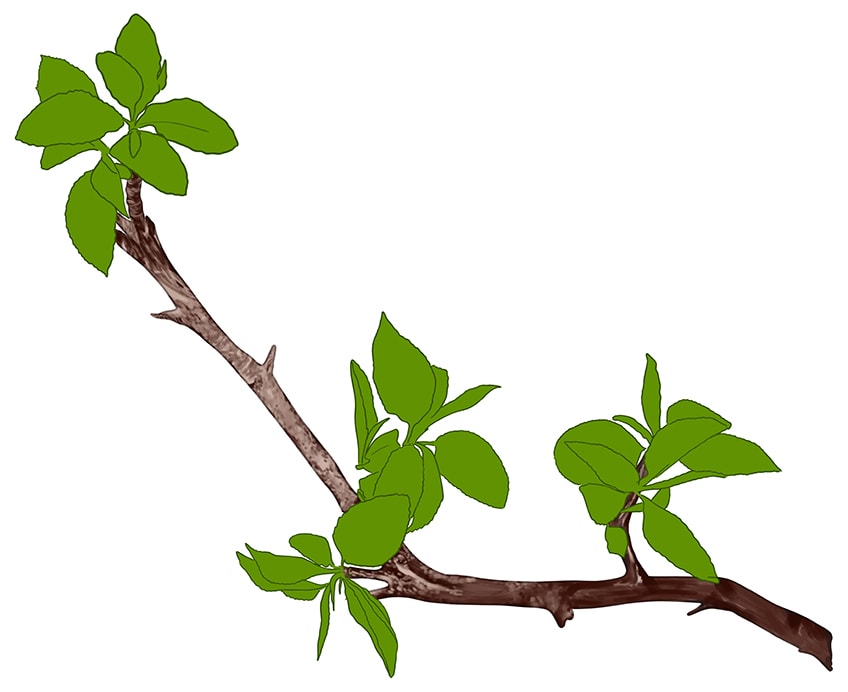
Step 12: Add Color Detail to the Leaves
We are now going to create some finer details on the leaves of your tree branch drawing. With a small blending brush and some bright, light green paint, add some highlights to each individual leaf. The base color should remain visible through the highlight, and the intensity of the color blending can vary between each leaf, creating a more realistic impression. Finally, use a fine detailing brush and a combination of light green and white paint to paint the vein lines on each leaf.
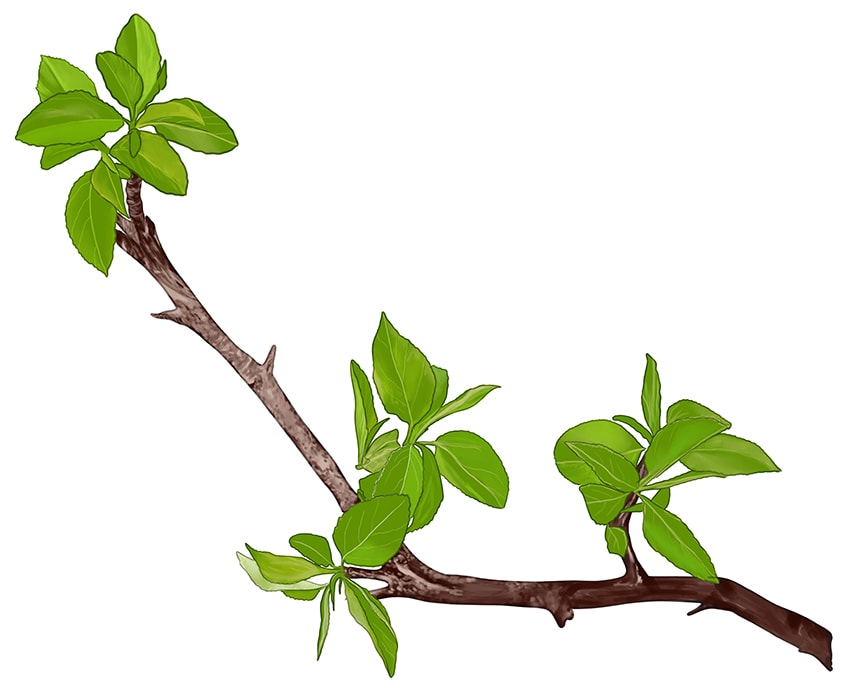
Step 13: Shade the Leaves
We are now going to add some shading to the leaves. Use a small blending brush and a shade of dark green paint to add some structure to each leaf. This shading should be focused along the edges and between the texture lines. Remember that you are in control of the light source, and as such, you can choose which sides of the leaves will be highlighted and which will be shaded.
Choose a particular direction and apply this to each of your leaves.
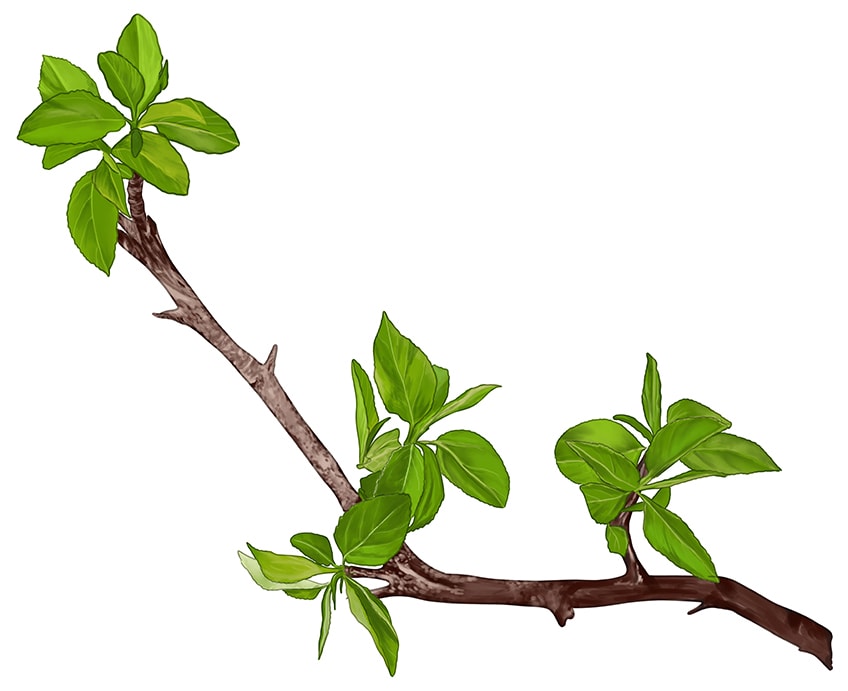
Step 14: Enhance the Structure Lines
With a fine detailing brush and a combination of white and bright green, enhance the texture lines with each leaf a little further.
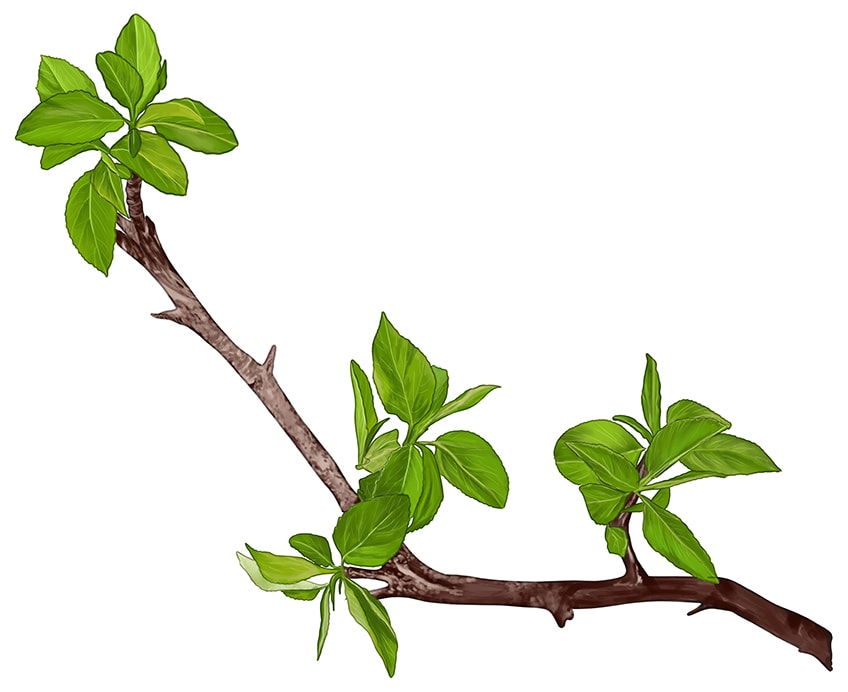
Step 15: Blend the Color on the Leaves
You can apply a gentle color blend between the ends of each leaf and the branch with a small blending brush and some light brown paint. In this way, you are creating a small stem for each leaf.
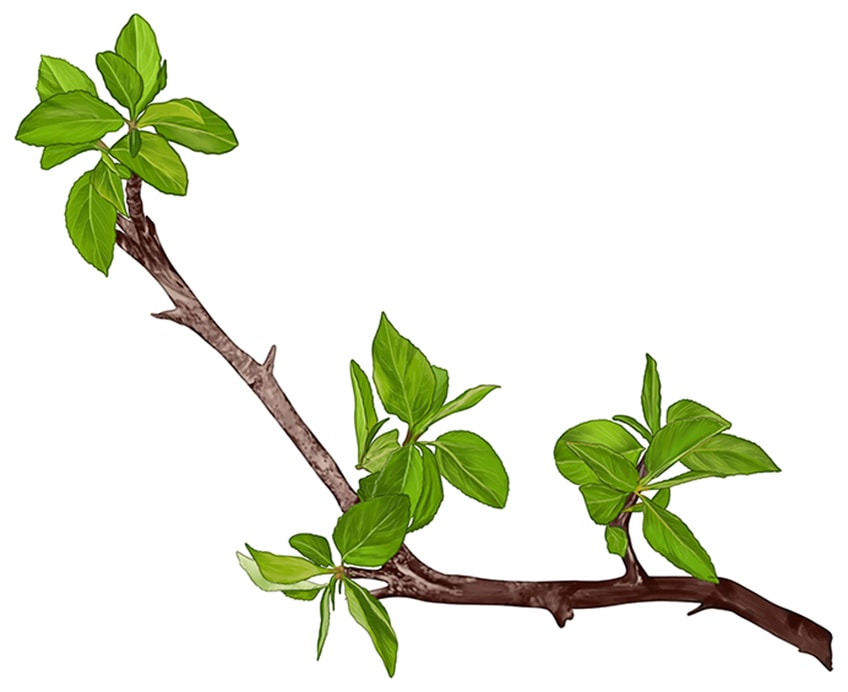
Step 16: Finish Your Tree Branch Drawing
In this final step, you are simply going to remove the tree branch outline. Using a fine brush and the corresponding color at each point of the outline, carefully trace over the dark lines. You will now be left with a seamless branch drawing that looks natural and realistic.
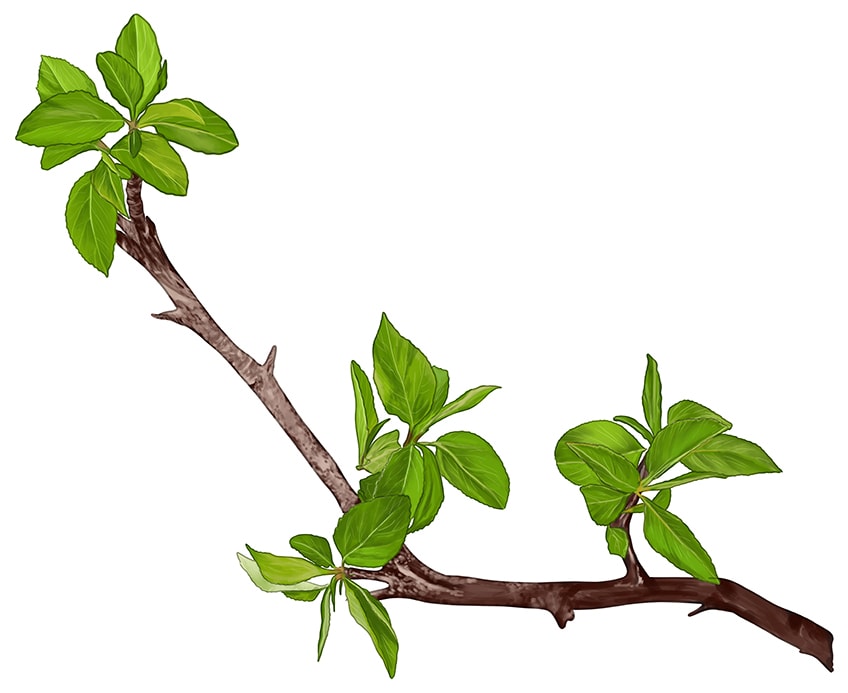
If you began this tutorial wanting to know how to draw a tree branch, and how to draw bark that is realistic, then we hope that you now have an answer. You have all the skills necessary to create realistic tree branches, with strong blending and constructing skills.
Frequently Asked Questions
How to Draw Bark on a Tree Branch?
Bark is probably the most tricky aspect of a branch drawing, but we make it very easy in our tutorial. With shading and highlighting in the correct spots, you can create a rough bark-like texture in only a few steps.
What Colors Do You Need for a Tree Branch Drawing?
There are a few basic colors that you will need to begin learning how to draw a tree branch. Firstly, you will need a few different tones of brown, including some darker and some lighter shades. You will also need several shades of green, and some basics like white and beige.
Source: https://artincontext.org/how-to-draw-a-tree-branch/
0 Response to "how to draw a tree branch without leaves"
Post a Comment